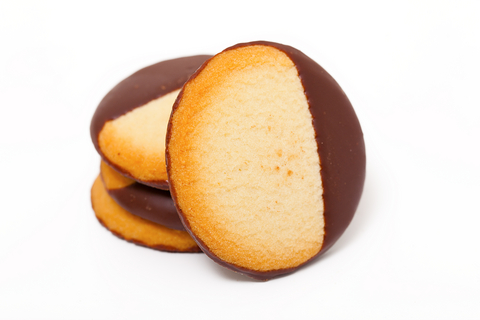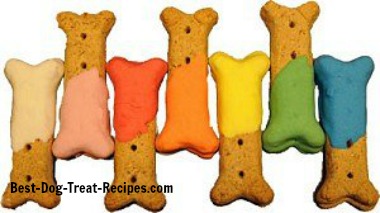White dipping chocolate, carob and yogurt coating and candy melts are used by dog bakeries to coat gourmet dog treats. There are pros and cons to each…
When I started Natural Pet Bakery, I did a lot of research, looking for dog treat icing before I decided what I would use.

Dogs can eat some sugar and it doesn’t affect their teeth nearly as much as sugar affects ours.
But, at the same time, I wanted to keep sugar to an absolute minimum! I found that there are several options.
You can decorate your dog cookies, yet still minimize the sugar by:
- using dog treat ingredients that are sugarless (or low in sugar)
- dog cookie icing as an accent, instead of covering the whole dog cookie
- using dog treat icing mixes that are sugar-free and fat-free

Carob Coating
Carob is naturally sweet. In some countries it is actually used as a sweetener. The sweetened carob coating that you buy from a bakery supplier does have some sugar, but it’s not a huge quantity.
One way to get around the sugar issue is to purchase unsweetened carob chips and melt them.
Carob coating looks like the dipping chocolate that you use to coat Easter eggs. In order to use it as a dog treat icing on dog treats or dog cookies, you need to melt it.
The best way to do this is to use a double boiler on top of the stove or in your microwave.
How to Work with Carob Coating
Heating the Carob
Carob coating can burn easily and when it gets too hot, the consistency can change and become kind of lumpy.
To prevent this, you can heat the water in the bottom of the double boiler (with the top removed) or your microwave.
And then, when it is boiling, remove it from the heat and put the top (with the carob in it) over the hot water. The carob coating will usually melt pretty well this way. The advantage is that you won’t burn or overheat the carob.
Thinning the Carob Coating
Sometimes the carob coating gets too thick, especially if you heat it a second time. If this happens, use 1 teaspoon to 1 tablespoon of vegetable oil or shortening and mix it in with the coating.
Don’t go overboard with this or your coating will get TOO soft and never harden! Or use a product like sugar-free coating flow crystals —which was designed for this purpose.
Applying Carob to your Dog Cookies
There are a couple of ways that you can apply the carob coating. You can apply it like you would frost a cake—using a non-serrated knife.
Or, you can dip part or all of the dog cookie into the melted carob. Or, lastly, you can drizzle interesting patterns onto your homemade dog cookies. An easy way to do this is to use a mustard or catsup bottle with a small opening!
Yogurt Coating Dog Cookie Icing
Yogurt coating is very close to carob coating and it looks like white dipping chocolate.
You would heat it the same way, thin it the same way, and apply it the same way as a carob coating dog treat icing.
Like white dipping chocolate, yogurt coating is white, and it usually contains some sugar. To color yogurt coating, you can use natural ingredients like turmeric powder (yellow), red beet powder (red), or spinach powder (green) or food coloring gel.
White Chocolate Candy Melts
Candy melts are wafers of white chocolate that are used in making candy. You can use the white chocolate wafers (and the colored white chocolate wafers) to frost your dog treats. Apply this chocolate to your dog cookies, the same as you would carob coating or yogurt coating.
The advantage to using candy melts as a dog treat icing is that they come in a variety of wonderful colors—and you don’t have to do a thing to color them. Or, buy the bright white ones and color them yourself.
The disadvantage to using these is that they contain more sugar than the other coatings, so, if you decide to use these, use just a little on your dog cookies.
Using white dipping chocolate, yogurt or carob coating or candy melts is a fun and easy way to decorate your homemade dog treats!
And if you have a dog bakery or give home-made dog treats as gifts, your decorated dog treats will look just like people cookies!



